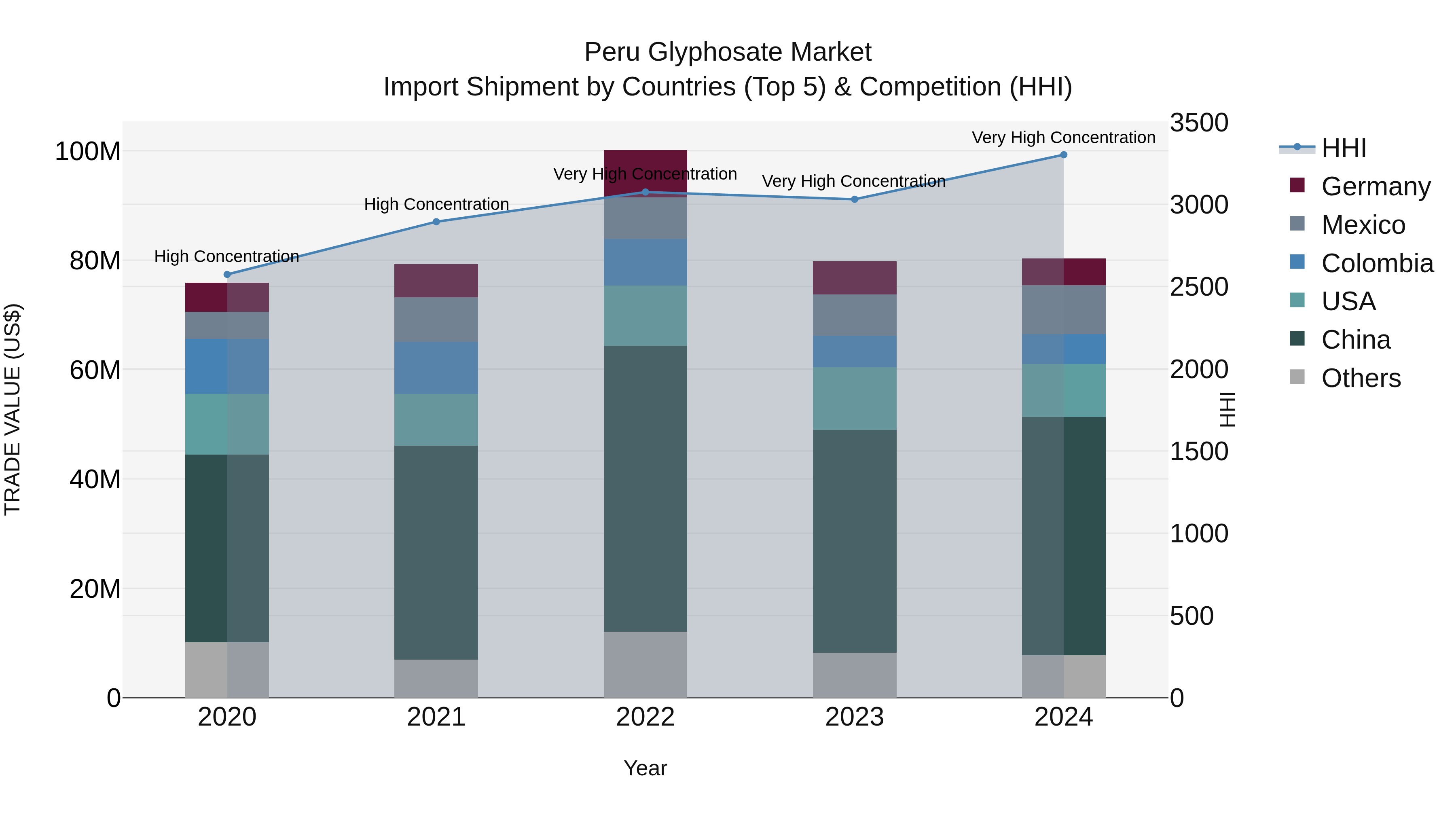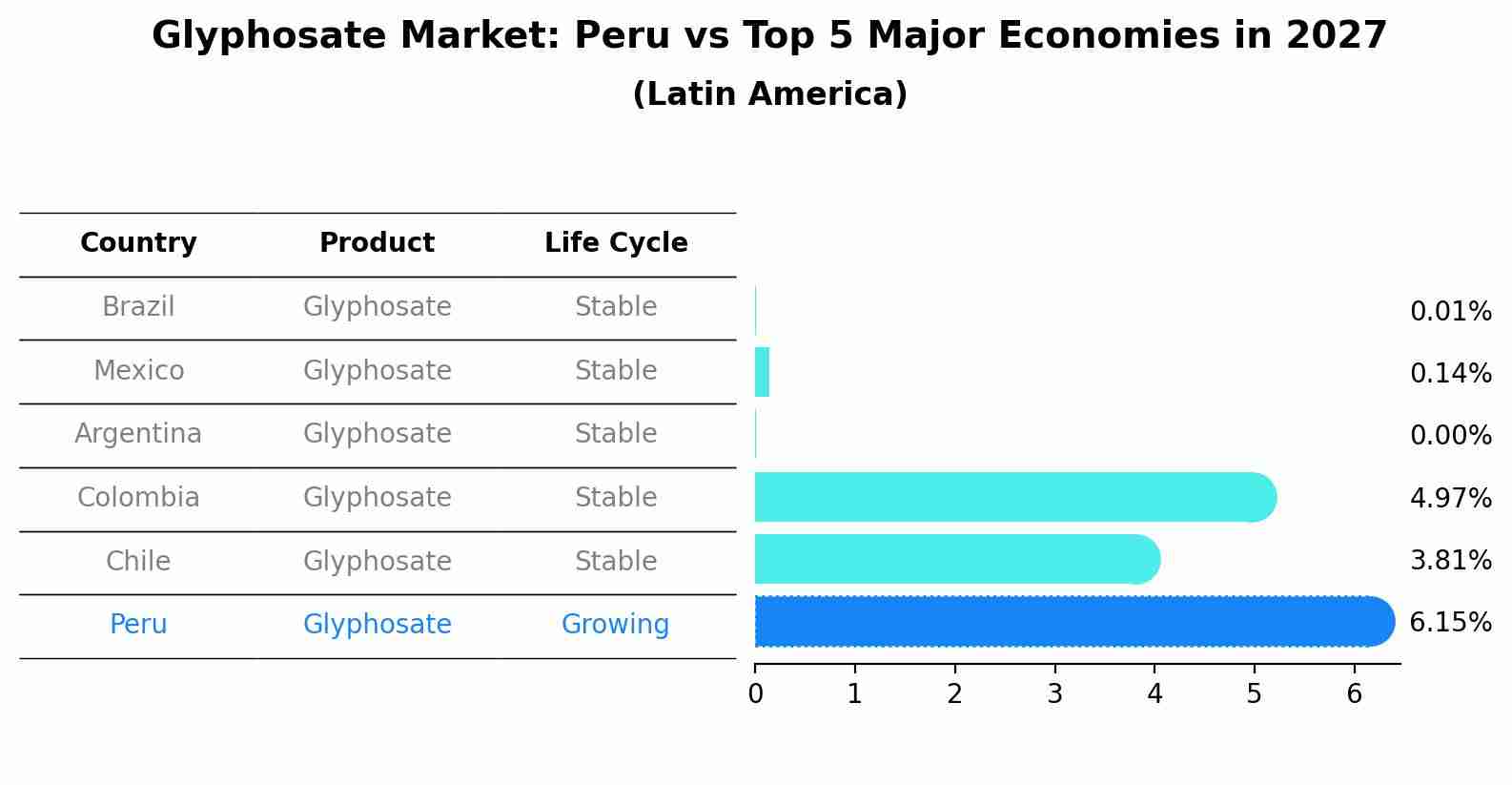Peru Glyphosate Market Outlook | Growth, Companies, Value, Forecast, Revenue, Trends, COVID-19 IMPACT, Share, Industry, Analysis & Size
| Product Code: ETC415742 | Publication Date: Oct 2022 | Updated Date: Nov 2025 | Product Type: Market Research Report | |
| Publisher: 6Wresearch | Author: Shubham Deep | No. of Pages: 75 | No. of Figures: 35 | No. of Tables: 20 |
Peru Glyphosate Market Top 5 Importing Countries and Market Competition (HHI) Analysis
In 2024, Peru continued to import glyphosate primarily from China, USA, Mexico, Colombia, and Germany, indicating a diverse global sourcing strategy. Despite a modest Compound Annual Growth Rate (CAGR) of 1.42% from 2020 to 2024, the High Herfindahl-Hirschman Index (HHI) suggests a concentrated market. The marginal growth rate of 0.63% in 2024 indicates a stable demand for glyphosate in Peru, with key exporters maintaining their market presence. This data underscores the importance of monitoring market dynamics and competitive landscape in the glyphosate sector.

Glyphosate Market: Peru vs Top 5 Major Economies in 2027 (Latin America)
The Glyphosate market in Peru is projected to grow at a growing growth rate of 6.15% by 2027, highlighting the country's increasing focus on advanced technologies within the Latin America region, where Brazil holds the dominant position, followed closely by Mexico, Argentina, Colombia and Chile, shaping overall regional demand.

Peru Glyphosate Market Synopsis
The Peru Glyphosate market is witnessing steady growth driven by the country`s expanding agriculture sector, particularly in the cultivation of crops like sugar cane, coffee, and fruits. Glyphosate, a widely used herbicide, is favored by farmers for its effectiveness in controlling weeds and increasing crop yields. The market is also benefiting from the increasing adoption of genetically modified (GM) crops that are engineered to be glyphosate-resistant. However, there are growing concerns regarding the environmental and health impacts of glyphosate, leading to stricter regulations and some opposition from environmental groups. Despite these challenges, the Peru Glyphosate market is expected to continue its growth trajectory, supported by the agricultural sector`s ongoing modernization efforts and the need for effective weed control solutions.
Peru Glyphosate Market Trends
Currently, the Peru Glyphosate Market is experiencing a shift towards more sustainable and eco-friendly alternatives due to increasing concerns about the environmental and health impacts of glyphosate-based products. There is a growing demand for organic and non-toxic weed control solutions, driving the market towards bio-based herbicides and natural alternatives. The Peruvian government has also been implementing stricter regulations on glyphosate usage, further pushing the market towards sustainable options. Additionally, there is a rising awareness among farmers and consumers about the potential risks associated with glyphosate, leading to a preference for safer and more environmentally friendly alternatives. Overall, the trend in the Peru Glyphosate Market is moving towards a more sustainable and health-conscious approach to weed management.
Peru Glyphosate Market Challenges
In the Peru Glyphosate Market, challenges are primarily related to environmental and health concerns. There is growing opposition to the use of glyphosate due to its potential negative impacts on biodiversity, soil health, and water sources. Farmers are also facing pressure to adopt more sustainable agricultural practices, leading to a shift away from chemical inputs like glyphosate. Additionally, government regulations and policies regarding the use of glyphosate are becoming stricter, adding to the challenges faced by companies operating in this market. As a result, there is a need for greater innovation in developing alternative solutions and practices that can effectively replace glyphosate while maintaining crop productivity and profitability for farmers in Peru.
Peru Glyphosate Market Investment Opportunities
The Peru Glyphosate Market presents several investment opportunities due to the widespread use of glyphosate-based herbicides in the country`s agriculture sector. Investors can consider opportunities in manufacturing and distribution of glyphosate-based products, as well as in research and development of alternative, more sustainable herbicide solutions to meet evolving regulatory and consumer demands. Additionally, there is potential for investment in providing training and education on responsible glyphosate use, as well as in offering consulting services to help farmers optimize their herbicide applications. With the increasing focus on environmental sustainability and food safety, investments in technologies that enhance the effectiveness and reduce the environmental impact of glyphosate usage could also be promising in the Peru Glyphosate Market.
Jordan Agar Market Government Policies
In Peru, the government has implemented strict regulations and restrictions on the use of glyphosate, a widely used herbicide. The Ministry of Agriculture and Irrigation oversees the approval and monitoring of glyphosate products, ensuring that they comply with safety and environmental standards. The government has also imposed limitations on the application of glyphosate in certain sensitive areas such as near water bodies, forests, and protected areas to minimize the risk of environmental contamination. Additionally, there are ongoing discussions and debates within the government and among stakeholders regarding the potential health and environmental impacts of glyphosate, which may lead to further regulations or even a potential ban in the future.
Peru Glyphosate Market Future Outlook
The future outlook for the Peru Glyphosate Market appears to be positive with steady growth expected in the coming years. Factors such as increasing demand for effective weed control solutions in agriculture, expanding agricultural activities, and government support for the use of glyphosate are likely to drive market growth. Additionally, advancements in formulation technologies, leading to more efficient and environmentally friendly glyphosate products, are anticipated to further boost market expansion. However, the market may face challenges related to regulatory concerns and growing awareness about the potential environmental and health impacts of glyphosate. Overall, the Peru Glyphosate Market is poised for growth, driven by the agriculture sector`s need for reliable and cost-effective weed management solutions.
Key Highlights of the Report:
- Peru Glyphosate Market Outlook
- Market Size of Peru Glyphosate Market, 2021
- Forecast of Peru Glyphosate Market, 2031
- Historical Data and Forecast of Peru Glyphosate Revenues & Volume for the Period 2018 - 2031
- Peru Glyphosate Market Trend Evolution
- Peru Glyphosate Market Drivers and Challenges
- Peru Glyphosate Price Trends
- Peru Glyphosate Porter's Five Forces
- Peru Glyphosate Industry Life Cycle
- Historical Data and Forecast of Peru Glyphosate Market Revenues & Volume By Application for the Period 2018 - 2031
- Historical Data and Forecast of Peru Glyphosate Market Revenues & Volume By Genetically Modified (GM) Crops for the Period 2018 - 2031
- Historical Data and Forecast of Peru Glyphosate Market Revenues & Volume By Conventional Crops for the Period 2018 - 2031
- Peru Glyphosate Import Export Trade Statistics
- Market Opportunity Assessment By Application
- Peru Glyphosate Top Companies Market Share
- Peru Glyphosate Competitive Benchmarking By Technical and Operational Parameters
- Peru Glyphosate Company Profiles
- Peru Glyphosate Key Strategic Recommendations
Frequently Asked Questions About the Market Study (FAQs):
1 Executive Summary |
2 Introduction |
2.1 Key Highlights of the Report |
2.2 Report Description |
2.3 Market Scope & Segmentation |
2.4 Research Methodology |
2.5 Assumptions |
3 Peru Glyphosate Market Overview |
3.1 Peru Country Macro Economic Indicators |
3.2 Peru Glyphosate Market Revenues & Volume, 2021 & 2031F |
3.3 Peru Glyphosate Market - Industry Life Cycle |
3.4 Peru Glyphosate Market - Porter's Five Forces |
3.5 Peru Glyphosate Market Revenues & Volume Share, By Application, 2021 & 2031F |
4 Peru Glyphosate Market Dynamics |
4.1 Impact Analysis |
4.2 Market Drivers |
4.2.1 Increasing adoption of genetically modified (GM) crops in Peru |
4.2.2 Growing demand for efficient and cost-effective weed control solutions in agriculture |
4.2.3 Rise in agricultural productivity and focus on enhancing crop yields |
4.3 Market Restraints |
4.3.1 Stringent regulations and restrictions on the use of glyphosate in agriculture |
4.3.2 Concerns over environmental and health impacts associated with glyphosate usage |
5 Peru Glyphosate Market Trends |
6 Peru Glyphosate Market, By Types |
6.1 Peru Glyphosate Market, By Application |
6.1.1 Overview and Analysis |
6.1.2 Peru Glyphosate Market Revenues & Volume, By Application, 2021-2031F |
6.1.3 Peru Glyphosate Market Revenues & Volume, By Genetically Modified (GM) Crops, 2021-2031F |
6.1.4 Peru Glyphosate Market Revenues & Volume, By Conventional Crops, 2021-2031F |
7 Peru Glyphosate Market Import-Export Trade Statistics |
7.1 Peru Glyphosate Market Export to Major Countries |
7.2 Peru Glyphosate Market Imports from Major Countries |
8 Peru Glyphosate Market Key Performance Indicators |
8.1 Adoption rate of GM crops in Peru |
8.2 Average farm productivity and crop yields |
8.3 Number of research and development initiatives aimed at improving glyphosate formulations |
8.4 Environmental impact assessments related to glyphosate usage |
9 Peru Glyphosate Market - Opportunity Assessment |
9.1 Peru Glyphosate Market Opportunity Assessment, By Application, 2021 & 2031F |
10 Peru Glyphosate Market - Competitive Landscape |
10.1 Peru Glyphosate Market Revenue Share, By Companies, 2021 |
10.2 Peru Glyphosate Market Competitive Benchmarking, By Operating and Technical Parameters |
11 Company Profiles |
12 Recommendations |
13 Disclaimer |
- Single User License$ 1,995
- Department License$ 2,400
- Site License$ 3,120
- Global License$ 3,795
Search
Thought Leadership and Analyst Meet
Our Clients
Related Reports
- Canada Oil and Gas Market (2026-2032) | Share, Segmentation, Value, Industry, Trends, Forecast, Analysis, Size & Revenue, Growth, Competitive Landscape, Outlook, Companies
- Germany Breakfast Food Market (2026-2032) | Industry, Share, Growth, Size, Companies, Value, Analysis, Revenue, Trends, Forecast & Outlook
- Australia Briquette Market (2025-2031) | Growth, Size, Revenue, Forecast, Analysis, Trends, Value, Share, Industry & Companies
- Vietnam System Integrator Market (2025-2031) | Size, Companies, Analysis, Industry, Value, Forecast, Growth, Trends, Revenue & Share
- ASEAN and Thailand Brain Health Supplements Market (2025-2031) | Strategy, Consumer Insights, Analysis, Investment Trends, Opportunities, Growth, Size, Share, Industry, Revenue, Segments, Value, Segmentation, Supply, Forecast, Restraints, Outlook, Competition, Drivers, Trends, Demand, Pricing Analysis, Competitive, Strategic Insights, Companies, Challenges
- ASEAN Bearings Market (2025-2031) | Strategy, Consumer Insights, Analysis, Investment Trends, Opportunities, Growth, Size, Share, Industry, Revenue, Segments, Value, Segmentation, Supply, Forecast, Restraints, Outlook, Competition, Drivers, Trends, Demand, Pricing Analysis, Competitive, Strategic Insights, Companies, Challenges
- Europe Flooring Market (2025-2031) | Outlook, Share, Industry, Trends, Forecast, Companies, Revenue, Size, Analysis, Growth & Value
- Saudi Arabia Manlift Market (2025-2031) | Outlook, Size, Growth, Trends, Companies, Industry, Revenue, Value, Share, Forecast & Analysis
- Uganda Excavator, Crane, and Wheel Loaders Market (2025-2031) | Strategy, Consumer Insights, Analysis, Investment Trends, Opportunities, Growth, Size, Share, Industry, Revenue, Segments, Value, Segmentation, Supply, Forecast, Restraints, Outlook, Competition, Drivers, Trends, Demand, Pricing Analysis, Competitive, Strategic Insights, Companies, Challenges
- Rwanda Excavator, Crane, and Wheel Loaders Market (2025-2031) | Strategy, Consumer Insights, Analysis, Investment Trends, Opportunities, Growth, Size, Share, Industry, Revenue, Segments, Value, Segmentation, Supply, Forecast, Restraints, Outlook, Competition, Drivers, Trends, Demand, Pricing Analysis, Competitive, Strategic Insights, Companies, Challenges
Industry Events and Analyst Meet
Whitepaper
- Middle East & Africa Commercial Security Market Click here to view more.
- Middle East & Africa Fire Safety Systems & Equipment Market Click here to view more.
- GCC Drone Market Click here to view more.
- Middle East Lighting Fixture Market Click here to view more.
- GCC Physical & Perimeter Security Market Click here to view more.
6WResearch In News
- Doha a strategic location for EV manufacturing hub: IPA Qatar
- Demand for luxury TVs surging in the GCC, says Samsung
- Empowering Growth: The Thriving Journey of Bangladesh’s Cable Industry
- Demand for luxury TVs surging in the GCC, says Samsung
- Video call with a traditional healer? Once unthinkable, it’s now common in South Africa
- Intelligent Buildings To Smooth GCC’s Path To Net Zero


















